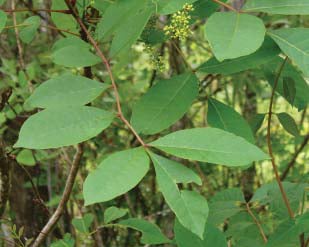With the 4th of July upon us, for many people, it's time to get out and enjoy some fresh air. From time with family to extended vacations, millions of us will be heading outside and enjoying the local park, greenway and hiking trails. Spending time out and about isn't without some risk though. Aside keeping your pets free of ticks and you free of mosquitoes, one of the most common things you will come across outdoors is poison ivy, poison oak and poison sumac. Here are some tips on how to spot these rash-inducing plants and avoid itching, swelling and annoyances they can cause.
These plants are all in the genus Toxicodendron (Greek for ‘poison tree’) and contain a resin called urushiol. Urushiol is found in the resin canals of leaves, stems, vines, berries and roots of the plants. When parts of these plants are damaged (stepped on, torn, bruised, etc.) the resin is released.  It is this resin that causes varying degrees of contact dermatitis for many of us.
It is this resin that causes varying degrees of contact dermatitis for many of us.
Although the resin in these plants is consistent all year round, the probability of coming into contact with your skin is higher in the summer. Why? Summer weather is when we tend to spend more time outdoors in shorts and t-shirts. Plus, it's more difficult to damage a plant when it's buried under a foot of snow.
Poison Ivy (Toxicodendron radicans)
‘Leaves of three, let it be.’
-
_
- Groups of three green leaves that change to yellow and red in the fall.
- As a deciduous woody perennial (can have woody stems and grow back annually) it can grow in the form of low lying plants, shrubs or as a vine. So no tree hugging!
 They can grow anywhere, and are found in woodlands, wetlands, on road sides, and seemingly just about anywhere.
They can grow anywhere, and are found in woodlands, wetlands, on road sides, and seemingly just about anywhere.
_
Poison Oak (Toxicodendron diversilobum)
- Basically the same as poison ivy, but with a set of three leaves that look like the round, white oak leaves.
- The urushiol causes a delayed allergic reaction with the body's immune system, so the worst symptoms won't appear until days or weeks later. Unfortunately this gives more time for the skin to absorb the resin.
Poison Sumac (Toxicodendron Toxicodendron vernix)
- Can grow as a shrub to a small tree (small being approximately 30 feet high).
- Leaves have 7-13 leaflets, and are two to four inches long, with a similar shape as the poison ivy.
- Tend to grow in very wet soils, such as swamps and peat bogs along the east coast and into Canada.
 Although not as widely distributed as poison ivy and poison oak, it's much more potent than the other two.
Although not as widely distributed as poison ivy and poison oak, it's much more potent than the other two.
For preventative measures, wear high wool socks and pants (if the weather isn't too unbearable), long sleeves and disposable gloves while outdoors to avoid any low lying toxicodendron species. Learn how to identify these plants so when you're trailblazing you won't have your outdoor adventures hampered by these itchy plants. If you notice that you've come in contact with these, try to wash the affected area with cool water and a mild soap as quickly as possible. The oil can sit on your skin and continue to create problems over larger areas for up to two days. In general, if you've been outdoors, it never hurts to wash your hands, arms and legs when you come in (besides it literally only takes a few minutes).
If you already find yourself itching or blistering, take comfort in calamine lotions or hydrocortisone creams. Take a few minutes to clean your nail beds in case you've gotten any of the resin underneath your nails. Some people will develop large, sensitive blisters. While the fluid in the blisters cannot spread the itch, popping them can lead to more severe problems, like infection or even blood poisoning. Blisters are the body
